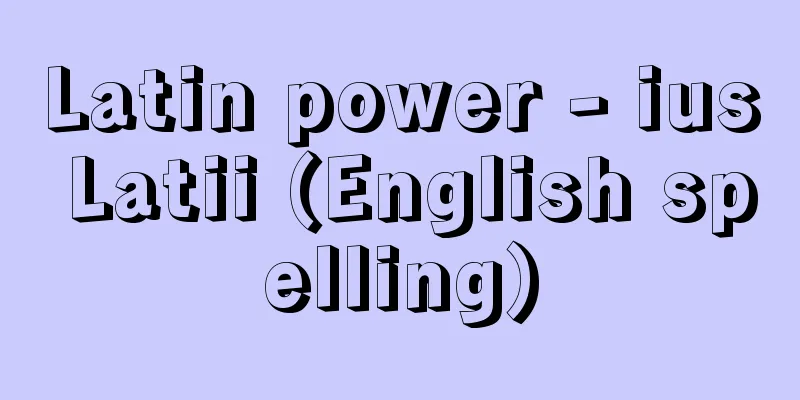Arata - Koden

|
Under the ancient Ritsuryo system, this refers to fields that have become desolate and are no longer cultivable. They are also called kohaiden (abandoned fields). They are different from sonden (damaged fields) that become desolate after spring cultivation. Abandoned fields include fukanden (unsustainable fields) that are not cultivated despite being listed as cultivable on the register, and jokoden (permanently desolate fields). In the Taiho Code, they are distinguished from the word kouchi (abandoned land), which means immature wilderness. In the Field Code Abandonment Article, abandoned fields that had been abandoned for more than three years were lent to those who wanted them and allowed to be cultivated again, but private fields such as kubunden (shared fields) were to be returned to the landowner after three years, and public fields such as nori-den were to be returned to the state after six years. However, the amount of abandoned fields increased, and in the early Heian period, they were given to princes and other officials as shiden (granted fields). In addition, in the Taihoden-rei, fields that were thin and could not be cultivated every year were called ekiden (easy fields). Later, unstable cultivated land that could not be cultivated every year and needed to be left fallow was called nenkou (yearly rough land) or kataarashi (half-rough land). On the other hand, those who reopened perennially rough land were granted lifetime usufruct rights. [Takehiko Yoshimura] "A Study of the History of the Establishment of the Feudal Lordship System in Japan" by Toda Yoshimi (1967, Iwanami Shoten)" ▽ "Japanese Thought Series 3: Ritsuryo" edited by Inoue Mitsusada and others (1977, Iwanami Shoten)" ▽ "A Study of the Social and Economic History of Ancient Japan" by Yanagida Teizo (1980, Iwanami Shoten)" ▽ "The Ritsuryo Field System and the Land Distribution Map" by Miyamoto Kyu (1998, Yoshikawa Kobunkan) Source: Shogakukan Encyclopedia Nipponica About Encyclopedia Nipponica Information | Legend |
|
古代の律令制において、荒廃して耕作が不能となった田地。荒廃田(こうはいでん)ともいう。春の耕種後に荒廃した損田(そんでん)とは異なる。台帳上では耕作可能にもかかわらず、実際は耕作されない不堪佃田(ふかんでんでん)や、恒常的な荒廃田である常荒田(じょうこうでん)も荒田である。大宝令においては、未熟荒野の地を意味する荒地(こうち)の語とは区別された。田令荒廃条では、3年以上経過した荒廃田は希望者に貸与して再開墾させたが、口分田(くぶんでん)などの私田は3年で田主に、乗田などの公田は6年で国家に返却させた。しかし、荒廃田は増加し、平安時代の初期には賜田(しでん)として親王らに与えられた。なお、地味が薄く、年ごとの耕作が無理な田地は、大宝田令では易田(えきでん)という。その後、毎年の耕作が不可能で休耕が必要な不安定な耕地は、年荒(ねんこう)や片荒(かたあら)しと呼ばれた。他方、常荒田を再開墾する者には、終身の用益権が認められるようになった。 [吉村武彦] 『戸田芳実著『日本領主制成立史の研究』(1967・岩波書店)』▽『井上光貞他校注『日本思想大系3 律令』(1977・岩波書店)』▽『弥永貞三著『日本古代社会経済史研究』(1980・岩波書店)』▽『宮本救著『律令田制と班田図』(1998・吉川弘文館)』 出典 小学館 日本大百科全書(ニッポニカ)日本大百科全書(ニッポニカ)について 情報 | 凡例 |
<<: Incense offering (incense offering) - Kouden
Recommend
Hakubi Line - Hakubisen
The name of the track of West Japan Railway Compa...
Ibrāhīm Pasha
1789‐1848 The second governor of Egypt (Wali) of t...
Illusionism
This refers to the technique and expression of pla...
emotion
...However, in contrast to the view that emotions...
Royal road - Oudou
A political way of governing with benevolence and...
Tail unit (English spelling)
…When we simply talk about wings, we are referrin...
Cucurbita pepo (English spelling) Cucurbitapepo
...In addition, it is resistant to soil-borne fus...
Stokowski
American conductor. Born to a Polish father and an...
Stewartia monadelpha (English spelling)
… [Susumu Ishizawa]. … *Some of the terminology t...
Tonan
A district in Morioka City, Iwate Prefecture. In ...
yellow sultan
...For potted plants and flower beds, dwarf speci...
Red Barnacle (English name) Megabalanus roseus
A marine animal of the order Sessile, family Barna...
Oose - Oose
A general term for a family or genus of the order...
balloon frame construction
…Singles, made by splitting cedar or oak into thi...
Winter aconite
...It has deeply lobed basal leaves with thin lon...









